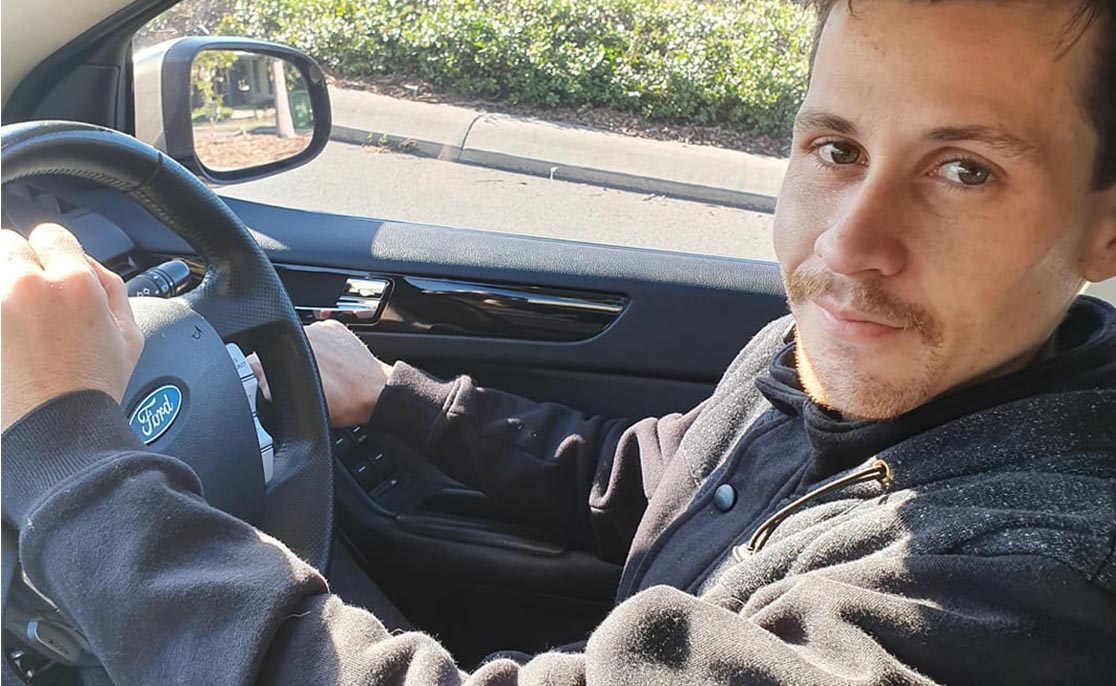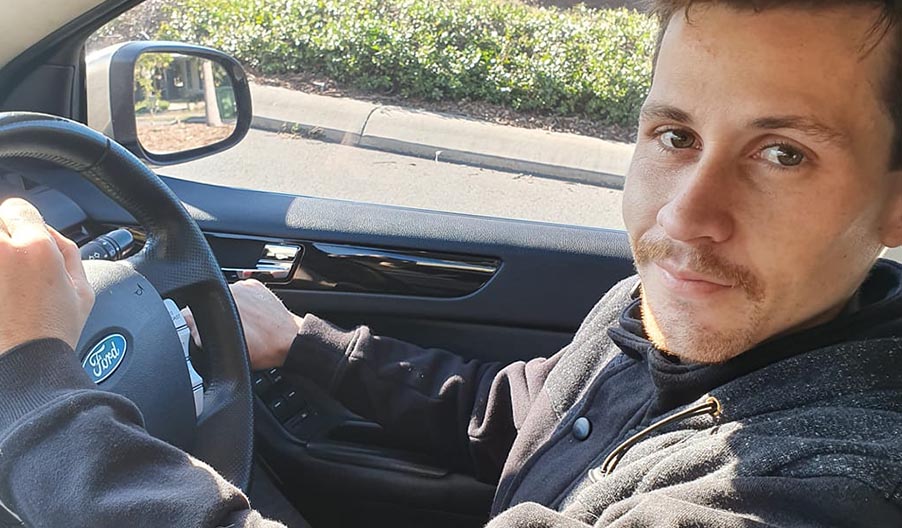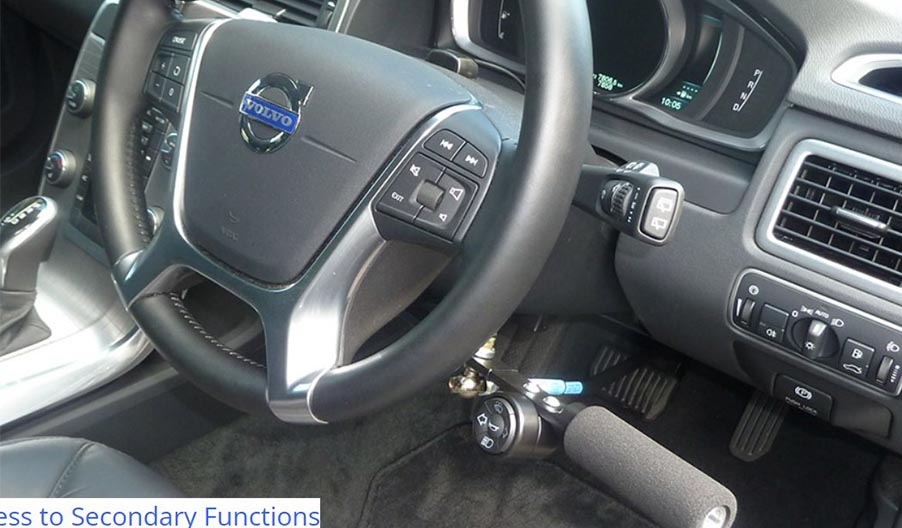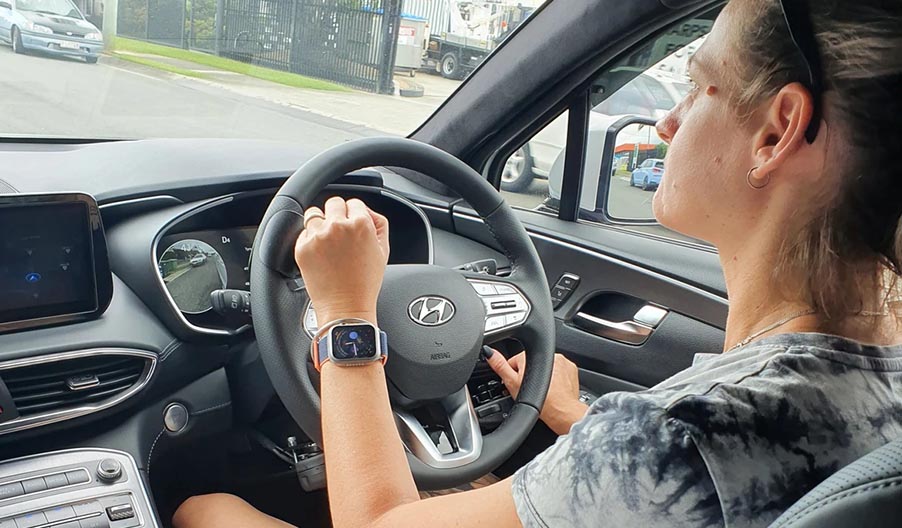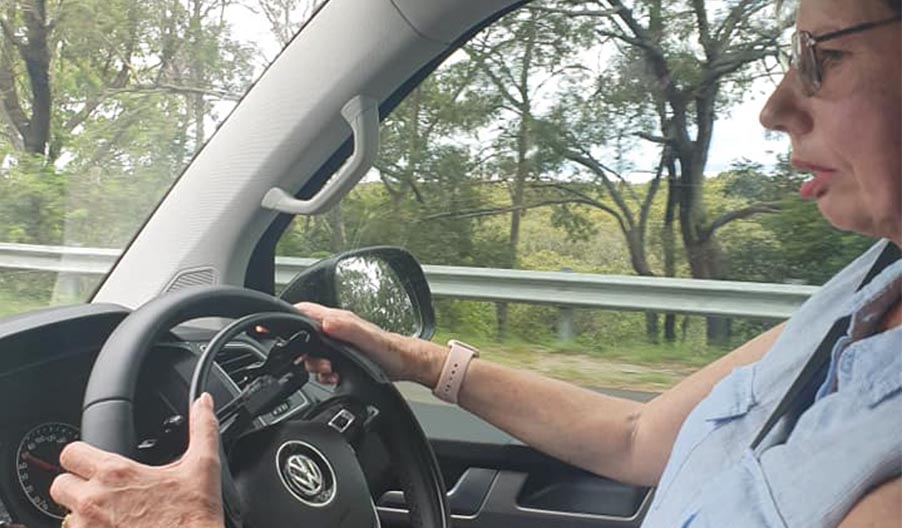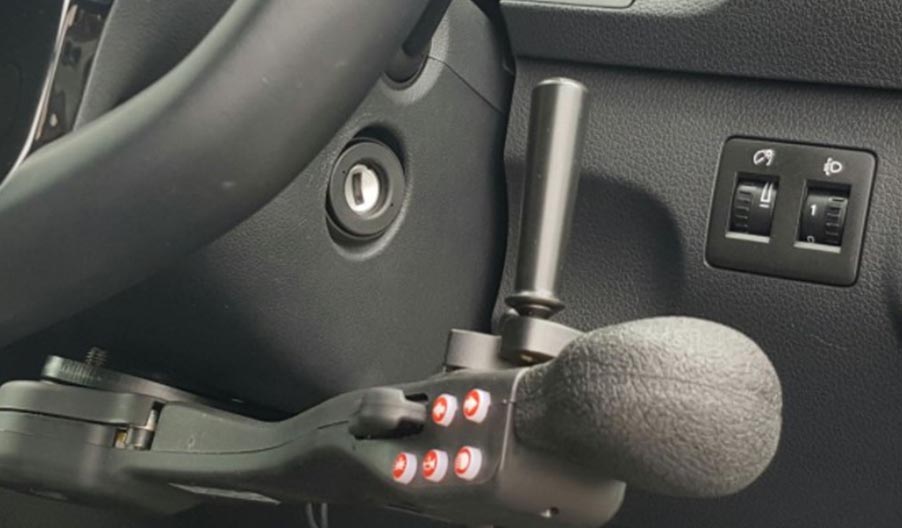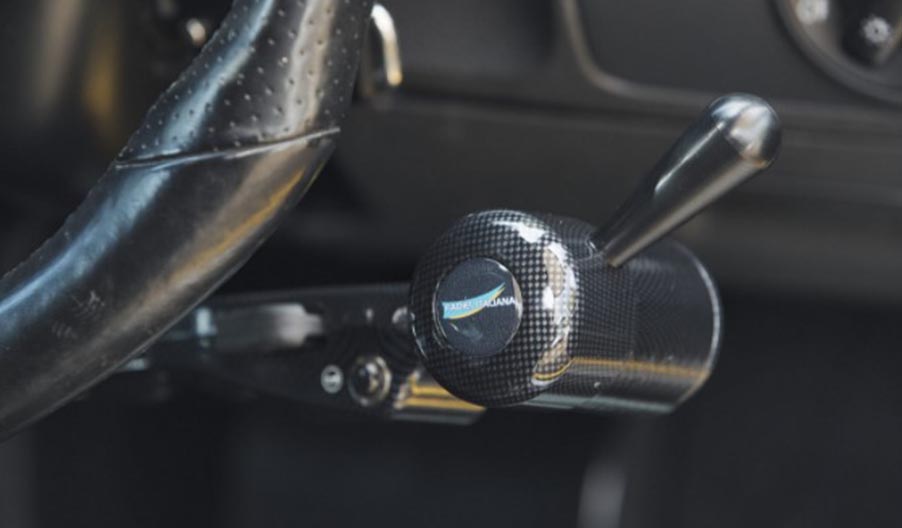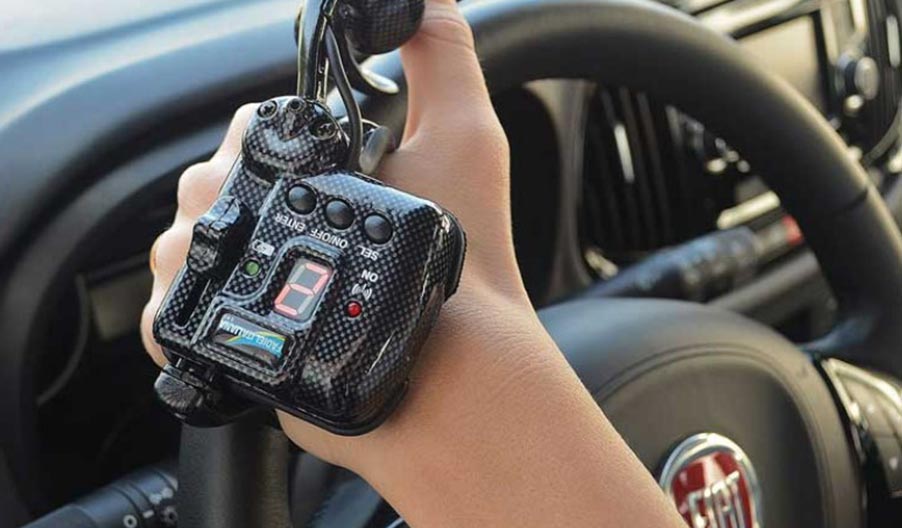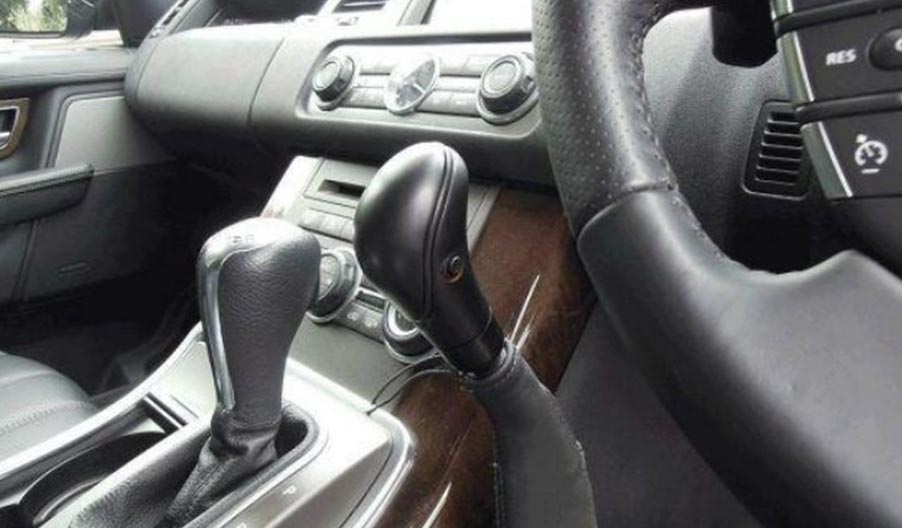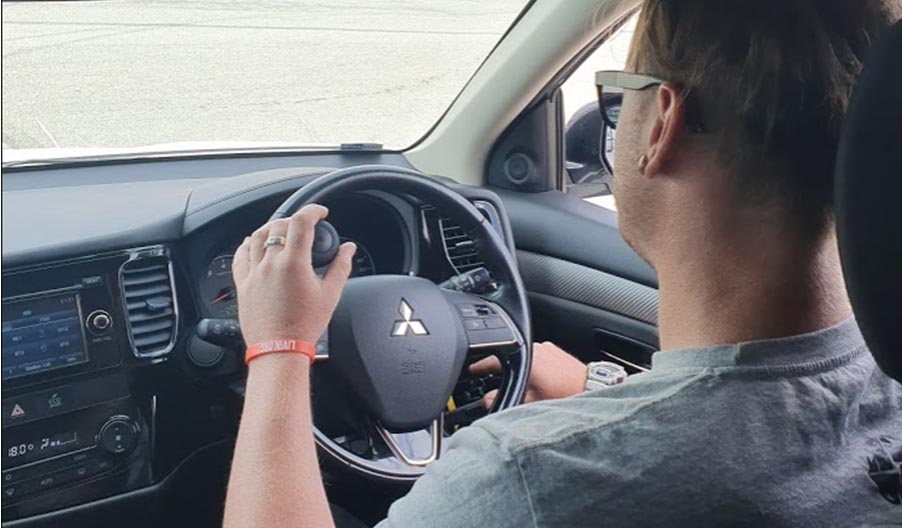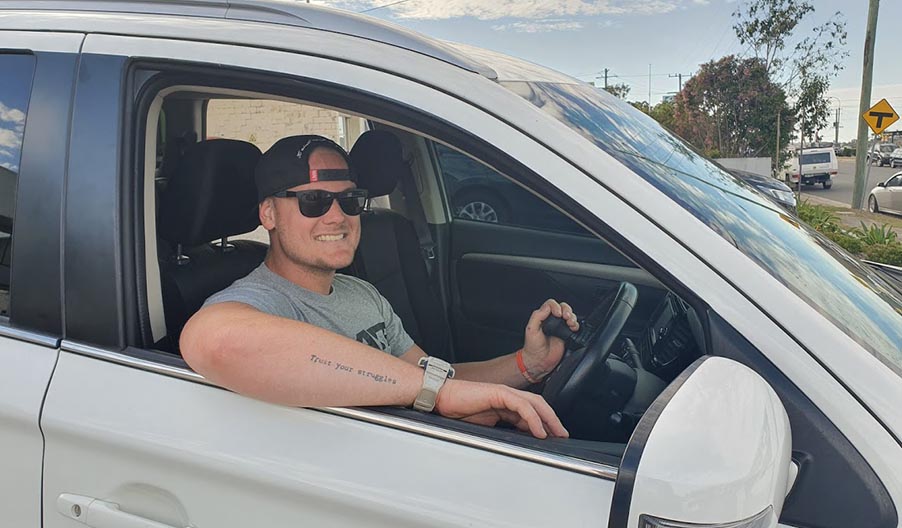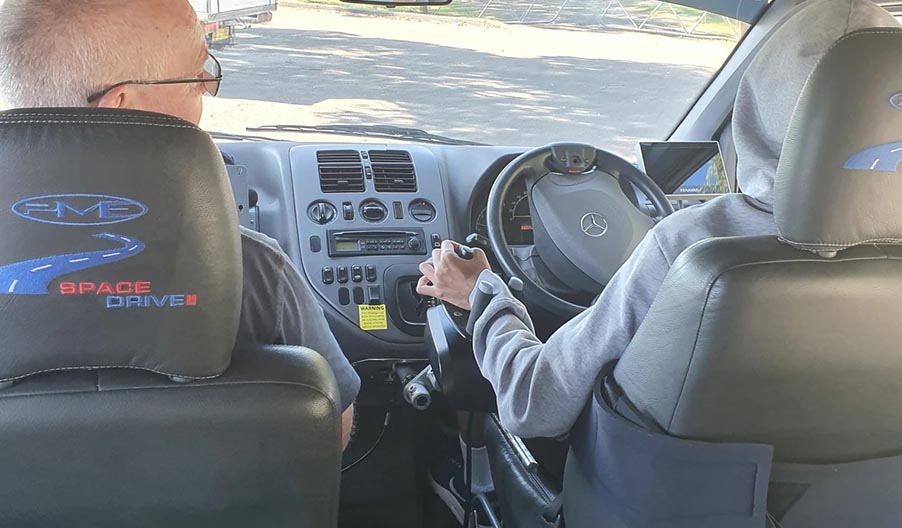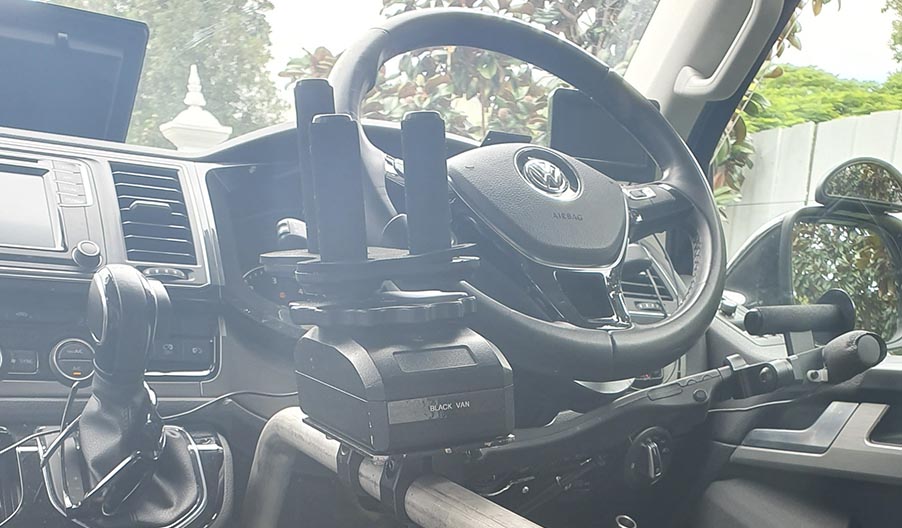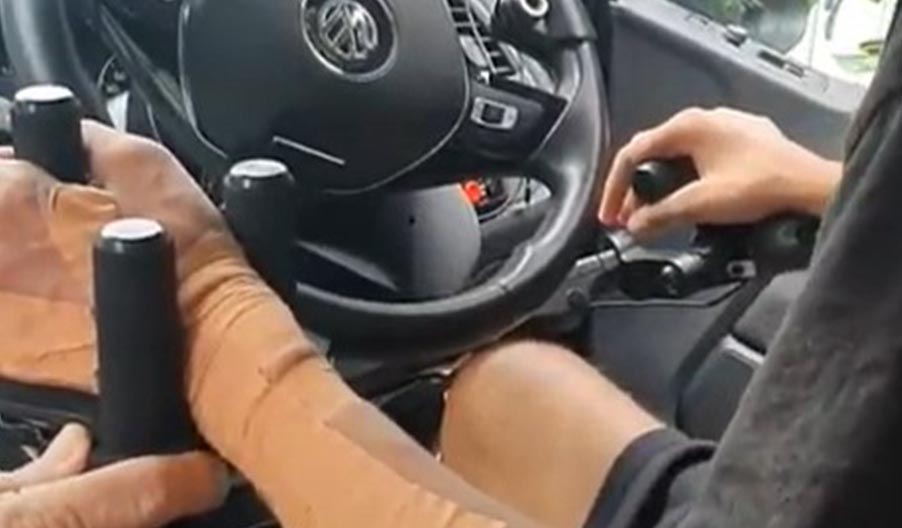When a person can’t use their lower limbs for operating brake/accelerator anymore (eg due to an injury such as lower limb amputation, or medical condition such as diabetes or multiple sclerosis), they will often be able to return to driving by using hand controls – this is where they have a lever that comes out from the steering column for braking, and then various different options for accelerating.
Two main types of hand controls: mechanical and electronic:
Mechanical hand controls
How do they work: “push-pat” – push the brake lever forwards for braking (braking is ALWAYS push forwards – because as humans we tend to put our hands out in front of us to stop us from falling), and “pat” it down for accelerating. This style has two rods that run down through the steering column, that connect to the pedals, so when you push the hand control, they activate the pedals.
For steering, a spinner knob is required to be able to operate the steering wheel safely with one hand. This is a requirement of all State Licencing Authorities, and a requirement of the governing guidelines AS/NZS 3954:2019 Motor Vehicle Driver Controls: adaptive systems for people with disabilities.
From left to right below:
Young fellow had his precious (and old) Ford Falcon, so had push-pat hand controls installed; close-up of push-pat hand control with electronic indicator panel, and close up of push-pat hand control with green toggle switch indicator.
Suitable for: these are a basic hand control that work well for older vehicles.
Problem: cars with knee airbags
- For newer vehicles, if they have a knee airbag (an airbag positioned near your right knee under the dash board, the mechanical hand controls ARE NOT compatible – if the knee airbag is deployed in a collision, then the airbag will snap the rods into your legs – definitely not good.
- Technically the knee airbag can be deactivated, but Transport authorities don’t like this (you need to apply for an exemption), and it may void the manufacturers warranty. The solution for newer vehicles that do have a knee airbag is electronic hand controls.
- This is old tech… it is on its way out… if these are installed, then the client upgrades their car which has a knee airbag, they will need to re-learn the new electronic hand controls and go through the whole driving assessment process again.
Electronic hand controls
How do they work: the brake lever is still connected to the pedals, so push forward on the lever activates the brake. This is typically positioned on the right hand side but can be trialled in some driving instructor vehicles on the left side. We usually like the stronger hand to operate the brake – stopping the car is the most important function in driving!
Then there are multiple options for accelerating – it depends on the person’s abilities such as dexterity, strength, sensory issues, any pain/fatigue. Common types are:
- Trigger accelerator: suitable with good finger dexterity – the index finger squeezes a small “trigger” to accelerate. A spinner knob is required on the steering wheel to steer safely with one hand. Indicators can be used on the hand control or on the spinner knob.
- E-radial or T-radial accelerator: suitable when there is poor finger dexterity – the hand/wrist/forearm rotates slightly to accelerate. A spinner knob is required on the steering wheel to steer safely with one hand. Indicators can be used on the hand control or on the spinner knob.\
- Satellite accelerator: this is a corded or wireless option device that sits on the back of the left hand, and thumb is used to squeeze a small lever to accelerate; also use the brake lever and standard indicators. Tricky to master, but a great option when two hands need to stay on the steering wheel due to shoulder strength issues. In my experience, this usually suits people with a car racing background.
- Overring accelerator: the accelerator is a ring that is installed onto the top of the steering wheel, that you squeeze gentle inwards to accelerator; still use the brake lever, steering wheel for steering and conventional indicator. Again, tricky to master but a great option where there is reduced shoulder strength; this is only available in one vehicle in Brisbane for trial.
- Carospeed hand control system: this is operated with the left hand, the hand control is pushed forwards for braking and pulled backwards for accelerating, indicators can be wired in, and a spinner knob on the right hand side. This is only available in one vehicle in Brisbane for trial.
From left to right below:
Female driver using the trigger accelerator; male driver using the satellite accelerator; female driver using the overring accelerator; close-up of the Fadiel FSK2005 brake lever/trigger accelerator; close-up of the Fadiel e-radial accelerator; close-up of the satellite accelerator; close up of the Carospeed hand control system (left side operated); male driver using the trigger accelerator.
Higher level needs
For people with higher level disabilities (eg quadriplegia) who need a little extra help, then the next level of hand controls are full electronic input systems – such as the mini-wheel or joystick, and “Freedom” brake/accelerator units. These are available from Problem Management Engineering and Total Ability and require very intensive assessment and trials, and intensive training.
Process
Getting back on the road with hand controls is a bit of a process, but so worthwhile. These steps will guide you through the process (bearing in mind the licencing process may vary from state to state – this is the QLD flavour)
1. Referral / intake
- Get a referral and QLD Transport Medical Certificate from your GP
- QTMC must state: “medically stable for purpose of OT driving assessment / lessons with driving instructor only”, and tick “M” medical condition and “V” vehicle modifications boxes
- take the completed QTMC to the QLD Transport office for processing – you will get an updated licence with these conditions according to the QTMC; you MUST check the expiry date and gain an updated QTMC when this expires!
2) OT driving assessment: clinical and practical assessment, to trial various hand controls.
At intake, your OT driver assessor should be able to work out with you which type of hand controls you will be most suited to, and book a specialised driving instructor with these type of controls in their vehicle.
If we haven’t nailed the hand control choice, we will do further drives in the same vehicle/hand controls to get a bit more practice and confirm, or we may do further drives with different hand controls (same instructor/vehicle or different instructor/vehicle).
If we’ve worked out the right hand controls for you, we’ll discuss the recommended number of lessons – this will vary between 5 to 10 lessons, right through to 15 to 20, or even 30 to 40 for high level electronic gear, dependent on previous driver experience (some clients are teens / learners and have never driven before) and your progress.
3) Recommendations and paperwork
Once a decision on the hand controls is made, the OT driver assessor completes report/s and obtains quote for driving lessons from the chosen driving instructor, which is submitted to the insurer for approval.
NDIS information:
When lessons are recommended, the OTDA will submit the OT driving assessment report and quote for the number of recommended lessons from the driving instructor provider, to the NDIA – “specialised driving training” is a quote required item, which needs to be approved by NDIA and added as a line item to your NDIA plan under Capacity Building: improved daily living (Specialised driver training 15_046_0129_1_3).
Once you have written approval from the NDIA, you are able to book your lessons directly with the driving instructor. (Note – as at February 2022, this is taking months to gain approval).
4) On-road re-assessment to review progress
For some clients, an OT on-road re-assessment will be completed part-way through their lessons, to check that everything is progressing as it should be, and gain the evidence to confirm that the modifications will enable the person to be a safe driver in the long term.
5) OT Driver Assessor to submit vehicle mods application
A vehicle modifications application is then completed and submitted to the insurer. This will typically include a suite of documents including:
- copy of driver’s licence
- copy of QLD Transport Medical Certificate
- the vehicle modifications application and signed consent forms
- OT driving assessment report/s
- letter from the client indicating that they consent to their vehicle being modified
- copy of vehicle registration and insurance
- vehicle Safety Certificate / Roadworthy may be required (at client’s expense)
NB: insurers have varying criteria about age and kilometres of the vehicle, which is considered to be “suitable” to modify. NDIS require no older than 5 years and no more than 80,000km – however, when minor modifications are being completed (including hand controls) which can be transferred to the next vehicle, they will usually accept this as long as the Safety Certificate is also provided.
6) Wait!
Await approval of the vehicle modifications. (again, there may be lengthy wait times for NDIS Participants).
7) Installation, lessons, license/medical certificate review
- Following approval, modifications are installed into the vehicle.
- Driving lessons should be occurring at this time.
- License/medical certificate will also be reviewed – the OT driver assessor will liaise with the driving instructor, and determine when it will be appropriate to provide an updated report to the GP to recommend an upgrade to the medical certificate – to remove the restriction of “driving with driving instructor only”. So it is off to the GP again to upgrade the medical certificate and this has to be taken to QLD Transport for processing, and provide copies to the OT Driver Assessor and insurer.
8) Handover assessment
- When the vehicle modifications are completed, our process at Driving Well Occupational Therapy is to complete a handover assessment at the modifier, with the client, OT Driver Assessor and Driving Instructor, to take the modified car for a test drive, and ensure everything is set up and working as it should be for the client.
- The OT will review the compliance documents of the modifications.
- Some clients will be able to drive their vehicle home, however sometimes this is not possible if the client is not yet competent or if there are tweaks needed to the mods.
Note: in QLD, a Transport driving test is not required, however this is a requirement in other states. In QLD, we need to be confident that the client is driving at the QLD Transport driving test standard, and that if they did have to complete a test, that they are at passing level.
9) Further lessons as needed
Some clients will have another few lessons in their own modified vehicle to gain experience and confidence.
10) Sign-off
OT driver assessor will complete final on-road report and post-modification evaluation report – these will be sent to QLD Transport and the insurer.
A celebration is definitely in order after all this! And for Driving Well, the handover days are the absolute highlight for us, our “WHY FACTOR” – this is why we do what we do!
Vehicle modifications network - who is who in the Driving Well zoo
Suppliers:
- Total Ability https://totalability.com.au/products/hand-controls/
- Problem Management Engineering https://www.pmeautoconversions.com.au/driving-controls/hand-controls
- Mobility Engineering https://www.mobilityengineering.com.au/
Brisbane vehicle modifiers:
- Alternate Mobility https://www.alternatemobility.com.au/
- Driving Mobility (formerly Auto Extras) https://drivingmobility.com.au/
- KCF Disability Engineering http://www.kcfdisabilityengineering.com.au/
Specialised driving instructors in Greater Brisbane region:
- Ivor Booker, Driver Education and Training Services (south side and Ipswich): mechanical hand controls, and operates specialised vehicles from Alternate Mobility in partnership with Total Ability
- Lorraine Anthony: mechanical hand controls
- Darren Innes, 21st Century Driving School (north side): electronic hand controls
- Easy Start Driving School (Andrew Mitsi): electronic hand controls
- My Driving School – Moreton Bay region (Liz Beggs): electronic hand controls, including the Carospeed system.
Check out our website www.drivingwell.com.au and get in touch if you need support with driving and/or vehicle access with a medical condition or disability.
#drivingassessment #handcontrols #vehiclemodifications #transport #independence #safety #driving #NDIS #occupationaltherapy #brisbane

